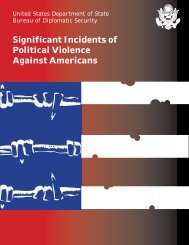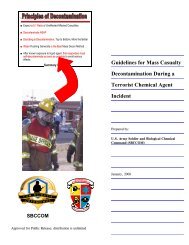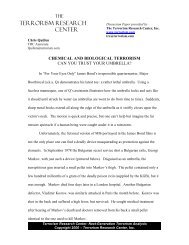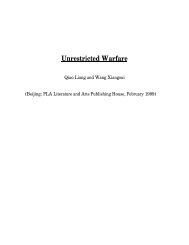Combating Proliferation of Weapons of Mass Destruction
Combating Proliferation of Weapons of Mass Destruction
Combating Proliferation of Weapons of Mass Destruction
Create successful ePaper yourself
Turn your PDF publications into a flip-book with our unique Google optimized e-Paper software.
Department <strong>of</strong> EnergyHistorical BackgroundThe history <strong>of</strong> the Department <strong>of</strong> Energy (DOE) is intimately linked to the development <strong>of</strong>U.S. nuclear proliferation-related policy. Even before the first detonation <strong>of</strong> an atomicbomb, the scientists <strong>of</strong> the Manhattan Project warned the War Department about thepotential dangers <strong>of</strong> proliferation. In 1945, the War Department’s Interim Committee onpost-war nuclear policy debated the alternative virtues <strong>of</strong> international cooperation versusstrict control over information about nuclear technology.As part <strong>of</strong> the reorganization <strong>of</strong> defense activities after the end <strong>of</strong> World War II, the U.S.Government decided that production <strong>of</strong> nuclear weapons should be the responsibility <strong>of</strong> acivilian agency rather than <strong>of</strong> the military establishment. The Atomic Energy Act <strong>of</strong> 1946established a five-member civilian Atomic Energy Commission (AEC) to take over theassets and responsibilities <strong>of</strong> the Manhattan Project on January 1, 1947.The 1946 Act also sought to prevent the proliferation <strong>of</strong> nuclear weapons by establishingstrict controls over fissionable material. Ownership <strong>of</strong> all fissionable material was vested inthe AEC, and its possession was forbidden to persons outside the jurisdiction and control<strong>of</strong> the United States. The Act also prohibited the direct or indirect production <strong>of</strong> fissionablematerial outside the United States. These provisions made it very difficult for the AEC toauthorize peaceful nuclear cooperation with other nations.A major policy change was announced in President Eisenhower’s 1953 “Atoms for Peace”speech to the United Nations. Recognizing that the United States no longer had amonopoly on nuclear technology, the President proposed to share nuclear materials andtechnology with other nations, provided that they undertook an obligation not to developnuclear weapons. As originally proposed, this cooperation was to be carried out under thecontrol <strong>of</strong> an international organization that eventually became the International AtomicEnergy Agency (IAEA).In 1954, Congress enacted amendments to the Atomic Energy Act to permitimplementation <strong>of</strong> the Atoms for Peace program. Beginning in the late 1950s, a network <strong>of</strong>peaceful nuclear cooperation agreements was negotiated, setting a pattern later followedby other nuclear supplier states. Initially, these agreements provided for safeguardsinspections to be conducted by the United States to verify that nuclear material <strong>of</strong> U.S.origin was not being diverted to military purposes. To carry out this responsibility, theAtomic Energy Commission developed the material accounting and control concepts andinspections techniques that underlie international safeguards to this day. In the late 1950sand early 1960s, the AEC worked closely with the IAEA to help the latter develop its ownsafeguards capability. This assistance to IAEA safeguards has been maintained by the60







